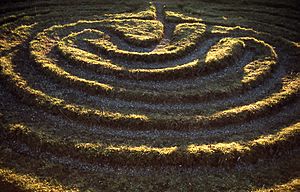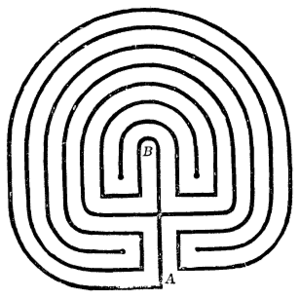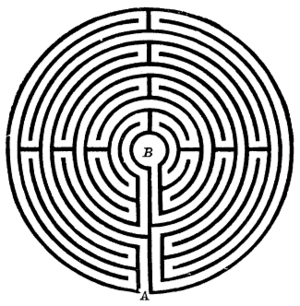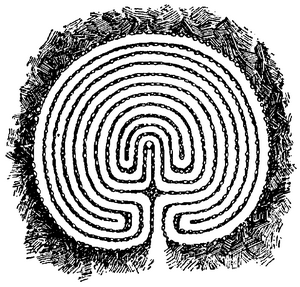Troy Town facts for kids
Many old mazes in England were called Troy Town or similar names like Troy's Walls. People believed the ancient city of Troy had walls that were so confusing, enemies would get lost inside. This is probably why these mazes got their name. In Wales, similar hilltop mazes were called "Caerdroia", which means "City of Troy" or "castle of turns".
Writers like W. H. Matthews and Adrian Fisher have studied these mazes. The name "Troy" has been connected to labyrinths for a very long time. An ancient Etruscan clay jar from Italy, made around 630 BC, shows a seven-ring labyrinth with the word TRUIA on it, which might refer to Troy. The ancient Roman event called the "Troy Game" also involved riding horses in maze-like patterns.
Contents
What are England's Historic "Troy" Mazes?
England still has eight old turf mazes, and three of them have "Troy" in their names. These mazes are made by cutting paths into the grass.
- "The City of Troy" is a small, well-kept maze near Dalby in North Yorkshire.
- "Troy" is a larger, beautiful maze in a private garden at Troy Farm in Somerton, Oxfordshire.
- "Troy Town" on St Agnes in the Isles of Scilly is a small maze made of turf and stones. It's thought to have been made in 1729 by a lighthouse keeper's son.
All three of these mazes follow the classical labyrinth design, like those found on old coins from Knossos. This is different from the medieval maze style. We don't know exactly when the Dalby and Somerton mazes were first built. However, the Dalby maze was re-cut in 1900 because a road damaged it.
Where Can You Find Surviving Troy Mazes?
- Near Dalby, North Yorkshire: "The Walls of Troy" (a seven-ring maze).
- Troy Farm, Somerton, near Banbury, Oxfordshire: "Troy" (a fifteen-ring maze).
- Troy Town, St. Agnes, Isles of Scilly: "Troy Town".
Lost Troy Mazes in England
Many "Troy" mazes from the past no longer exist. Here are a few examples that were mentioned in W.H. Matthews' book Mazes and Labyrinths from 1922:
- "Troy-town" near Dorchester, Dorset. The maze is gone, but the name "Troy Town" is still used for the area.
- On Hilldown, a hill between Farnham and Guildford, Surrey, there was a "Troy-town".
- "The Walls of Troy" in Holderness, East Riding of Yorkshire. This one had a unique twelve-sided shape.
- "Troy-town" in Pimperne, Dorset. This maze had a unique, roughly triangular design. It was described in 1686 but ploughed up in 1730.
- In the marshes between Burgh and Rockliffe, Cumbria, there were "The Walls of Troy" and two other turf mazes.
- A "bower" or "Troy-town" in Walmer, Kent.
Troy Labyrinths in Northern Europe
You can find similar labyrinths in northern parts of Europe. Unlike the turf mazes in England, these have their paths outlined with stones. It's been easier to figure out the age of these stone labyrinths. Those around the Baltic Sea were built between the 13th century and modern times, with many made in the 16th and 17th centuries.
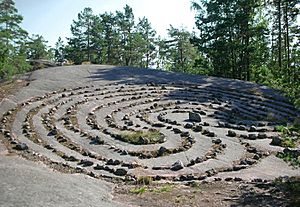
There used to be hundreds, maybe even thousands, of these stone labyrinths around the Baltic Sea, in Fennoscandia (like Sweden, Norway, Finland) and the Baltic countries. Many still survive, especially in remote areas. You can also find similar stone labyrinths in the Kola Peninsula and along the coasts and islands of the White Sea.
For some reason, almost all of these northern labyrinths are found close to the sea. Some people think sailors used them, maybe even for navigation. Many stone labyrinths along the Swedish coast of the Baltic Sea were built by fishermen during bad weather. They believed these mazes could trap evil spirits, called "smågubbar" or "little people", who brought bad luck. The fishermen would walk to the center of the labyrinth, hoping the spirits would follow them. Then, they would quickly run out and go to sea.
Several classical-style labyrinths in Scandinavia have names like Trojaborg or Trojborg, which all mean "City of Troy". In Finland, these labyrinths are called Jatulintarha ("giant's garden") or jättiläisen tie ("giant's road"). In Finland, they were also named after important biblical places, like Jerusalem. Walking through the maze was seen as a symbolic pilgrimage to the place it was named after. In Finnish areas where Swedish is spoken, the labyrinths are called jungfrudans or "maiden's dance".


